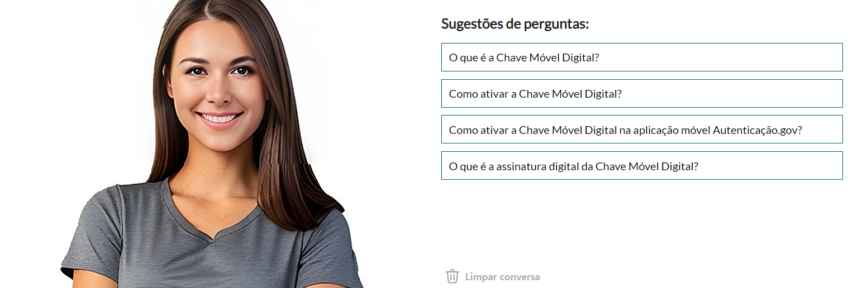The Virtual Assistant project targets every person that may come to require information on how to access and make use of Portuguese Public Services. It takes the shape of an AI driven ChatBot (powered by ChatGPT3.5), designed on Azure Cloud AI architecture as a public/private partnership. Our Innovation demonstrates a clear use case for AI within the public sector, and it was developed to address effectiveness, efficacy and quality issues inherent to the provision of public services.
Innovation Summary
Innovation Overview
This innovation sought to answer to the constant demand for customer assistance that exists within public service provision (i.e.: how can a citizen access certain services?; what are the requirements for access?; do they have to pay any fees?) put together with the issue of how the process of providing support in and of itself can be as far reaching, equitable and sustainable as possible.
The Innovation takes the shape of an AI driven ChatBot housed within Portugal’s Public Service Portal – the e-portugal.gov.pt website, which aggregates all public services. Currently, the Virtual Assistant works on queries related to activation of the Digital Mobile Key (CMD), the digital authentication mechanism for Portuguese citizens, but, expansion updates are already being developed.
Our objectives with this product were:
- The implementation of a 24/7 support line for queries related to public services;
- Provide a use case for AI in the Public Sector;
- Develop a tool that can help reduce queue times on our support telephone lines and improve customer experience at the physical shops;
Moving forward, the project aims to increase coverage of public services to all those available in the ePortugal website and the number of languages it can understand. The goal of these developments is to save even more time and effort for other areas of public administration. Ultimately to promoting more efficient and environmentally minded public services by cutting on energy spent, paperwork filed, and time expended in issues that could otherwise be easily solved by the chatbot.
Innovation Description
What Makes Your Project Innovative?
The Virtual Assistant is unique for our organization as we have never produced something to this scale before. While we have developed a guide for ethical use and implementation of AI and have experimented with more limited chatbots, the Virtual Assistant is a magnitude of complexity above any of our previous AI projects. As our agency is responsible for driving the modernization of public services and administration, AMA is a pioneer for the implementation of this technology at a national level.
What is the current status of your innovation?
Our project so far has produced around a 10% increase in output for the specific public service it targets. This has bolstered our resolve to expand the project’s reach into other areas of Portuguese public services.
Now, the Virtual Assistant is currently in its early stages, only providing support towards a single facet of our public services. Our goal for the near future is to introduce a new version of the Virtual Assistant able to interact with non-portuguese speaking persons on several key public services. The goal is to provide interactions in a large number of languages to minimize administrative effort and offer quality services to everyone.
Innovation Development
Collaborations & Partnerships
The Virtual Assistant was worked on through a public private partnership involving several companies, namely: Microsoft; Defined.ai; and Daredata. Microsoft assisted us with Cloud Azure OpenAI, Defined.ai optimized the language model to Portuguese and developed the Avatar and Daredata helped us with the integration and implementation of the project.
Users, Stakeholders & Beneficiaries
From the point of view of the public sector entities, the Virtual Assistant provides a service support and provision platform capable of cutting administrative costs, reducing wait times, and increasing efficiency, therefore moving towards the green transition.
For citizens, the Virtual Assistant promises a ready to serve mechanism capable of taking in queries at any time, equipped with state-of-the-art technology for the purpose of streamlining their interactions with public services.
Innovation Reflections
Results, Outcomes & Impacts
From MAY-DEC23 the chatbot has had 23.780 conversations (101/day on average). Main requests answered so far involve the following topics: CMD activation; digital signature; expiry date of the CMD. Since the activation of the Virtual Assistant, we have noticed around a 10% increase in the number of CMD activations.
In the near future, we expect to be able to employ the Virtual Assistant towards simplifying public services for non-Portuguese speaking persons, providing them support when interacting with service providers. We also expect an increased capacity for covering different public service topics, allowing for more Public Administration entities to reap the benefits of the virtual assistant leading to more user-driven public services.
Challenges and Failures
- Complexity of the information involved: The project aims to present complex and multifactor information in a simple and conversational manner, which can prove challenging.
- Multi-entity involvement: The Virtual Assistant requires multiple government entities and institutions to collaborate, each with their own priorities and processes. Coordinating and aligning these entities can be a challenge.
- Data quality assurance: Formulating valid and logical responses to the final user’s queries requires drawing from a considerable knowledge base, which needs to be checked and tested along the way several times.
- Hallucinations: A lot of training is required to stop the ChatBot from generating answers based on false or partially incorrect information.
Conditions for Success
- R&D budgeting: Investment in research and development is required for the continuous improvement needed to develop the Virtual Assistant.
- Technical feasibility: Meeting the needs and expectations of users – especially in the public service context – is a demanding task. As such, assuring that we have both the best tools and the right knowledge is essential not only in the development but also implementation and deployment of our solutions.
- Cooperation with stakeholders: Engaging and involving relevant stakeholders (public and private) is critical to success. This implies the need for prolonged collaboration, regular exchange of feedback and support in the development and implementation of the ChatBot.
Replication
This project was designed based on Azure Cloud AI architecture and was a joint effort between public and private sector tech companies. Several examples of AI chatbots exist for a myriad of purposes, so having one working for the public sector is another example of the AI chatbot application.
As mentioned, we are working on broadening the ChatBots capabilities to encompass more public sector entities, so in a way we are already replicating what we did with the first iteration of the virtual assistant.
We have already presented this service to other countries’ public administrations to show the viability of this solution and they have signalled interest in replicating this sort of model into their own services.
Lessons Learned
Ultimately, the implementation of AI chatbot technology into public administration has contributed to both greater efficacy resource allocation and better efficiency in service delivery.
Our experimentation with developing and implementing the chatbot has exposed AMA to various challenges. As mentioned before, from hallucinations to coordinating with different branches of the public sector, the vast know-how acquired during these exercises has proven to be a valuable asset in our efforts to digitize public services.
Status:
- Identifying or Discovering Problems or Opportunities - learning where and how an innovative response is needed
- Generating Ideas or Designing Solutions - finding and filtering ideas to respond to the problem or opportunity
- Implementation - making the innovation happen
Date Published:
20 February 2025


